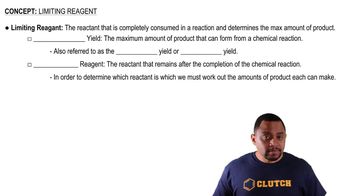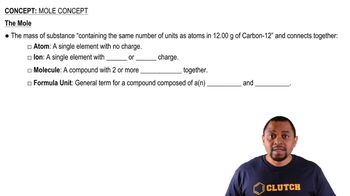Consider the mixture of ethanol, C2H5OH, and O2 shown in the accompanying diagram. (c) How many molecules of CO2, H2O, C2H5OH, and O2 will be present if the reaction goes to completion?

Sodium hydroxide reacts with carbon dioxide as follows: 2 NaOH(s) + CO2(g) → Na2CO3(s) + H2O(l) Which is the limiting reactant when 1.85 mol NaOH and 1.00 mol CO2 are allowed to react?
 Verified step by step guidance
Verified step by step guidance
Verified video answer for a similar problem:
Key Concepts
Limiting Reactant

Stoichiometry

Mole Concept

Consider the mixture of propane, C3H8, and O2 shown here. (a) Write a balanced equation for the combustion reaction that occurs between propane and oxygen.
Consider the mixture of propane, C3H8, and O2 shown here. (c) How many molecules of CO2, H2O, C3H8, and O2 will be present if the reaction goes to completion?
Sodium hydroxide reacts with carbon dioxide as follows: 2 NaOH(s) + CO2(g) → Na2CO3(s) + H2O(l) How many moles of Na2CO3 can be produced?
Sodium hydroxide reacts with carbon dioxide as follows: 2 NaOH1s2 + CO21g2¡Na2CO31s2 + H2O1l2 How many moles of the excess reactant remain after the completion of the reaction?
Aluminum hydroxide reacts with sulfuric acid as follows: 2 Al1OH231s2 + 3 H2SO41aq2¡Al21SO4231aq2 + 6 H2O1l2 Which is the limiting reactant when 0.500 mol Al1OH23 and 0.500 mol H2SO4 are allowed to react?
